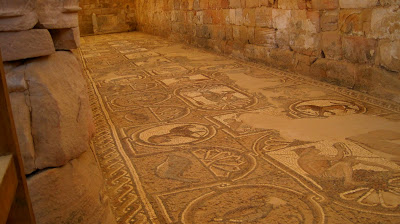Behind the curvy rocks of the Siq we catch a dramatic, stop-you-in-your-tracks glimpse of Petra’s Treasury, Al-Khazneh. Jordan’s most famous site was, by the 2nd century BC, the capital of the Nabataean Kingdom and an important mercantile center for traders in camel-laden caravans bringing silks and spices from as far away as China. The Nabataeans grew wealthy imposing a sales tax on transactions.
Petra still serves thousands of visitors daily, arriving from caravans of buses. Another UNESCO World Heritage Site, Petra is often listed as one of the top places to see before you die.


Camels seem to be perennially in repose in front of The Treasury.
 In 106 AD Petra was annexed by the Romans. Their influence is seen in some of the embellishments and architecture but as the Roman trade routes bypassed Petra, the once thriving city fell into decline.
In 106 AD Petra was annexed by the Romans. Their influence is seen in some of the embellishments and architecture but as the Roman trade routes bypassed Petra, the once thriving city fell into decline.



 Stripes and swirls of yellow, gold, white, pink and purple layers of sandstone provide natural adornment of the city.
Stripes and swirls of yellow, gold, white, pink and purple layers of sandstone provide natural adornment of the city.
 Wild oleander grew everywhere providing a sense of abundance to the site. Petra's amphitheater is in the background.
Wild oleander grew everywhere providing a sense of abundance to the site. Petra's amphitheater is in the background.

 In 106 AD Petra was annexed by the Romans. Their influence is seen in some of the embellishments and architecture but as the Roman trade routes bypassed Petra, the once thriving city fell into decline.
In 106 AD Petra was annexed by the Romans. Their influence is seen in some of the embellishments and architecture but as the Roman trade routes bypassed Petra, the once thriving city fell into decline.


 Stripes and swirls of yellow, gold, white, pink and purple layers of sandstone provide natural adornment of the city.
Stripes and swirls of yellow, gold, white, pink and purple layers of sandstone provide natural adornment of the city.  Wild oleander grew everywhere providing a sense of abundance to the site. Petra's amphitheater is in the background.
Wild oleander grew everywhere providing a sense of abundance to the site. Petra's amphitheater is in the background.A guide stops to rest in the shade.
Mosaics remain from a Roman church.
After a full day of walking these handsome camels called to us for a lumbering but easy ride back to the Siq.
Just a final sip of Sprite and we're ready to go.


















Martha, that image #1 is outright fabulous. The intensity of the light gets excellently emphasized by those dark rock walls leading the view to the center.
ReplyDeleteThank you, Markus. It was quite a sight at the end of the Siq.
ReplyDelete